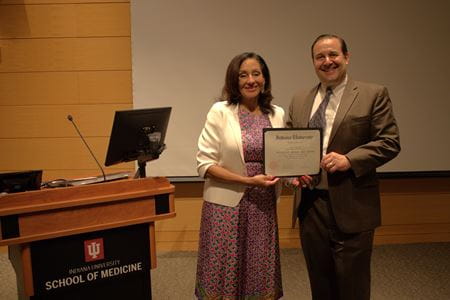“I think one of the drivers of the research success in our department is the passion that the people in our department have for women's health,” Haas says. “We all want to optimize health, and we know that there are many unanswered questions.”
In addition to featuring research from PGY3 residents and fellows, the event is an opportunity to reflect on the department’s research successes. “The department's leadership has assembled a faculty of people who want relevant questions answered and are willing to take steps to answer them,” Haas notes. “The department has invested in these people and programs, and that directly leads to the successes we see.” Research Day is an opportunity to highlight a few of those research successes.
Hunter Lecture
Research Day also houses the annual Hunter Lecture. The Hunter Lecture is held in honor of former chair Charles A. Hunter Jr., MD. Each year, an outstanding advocate and scholar from the obstetrics and gynecology field is invited to Indiana University Indianapolis to speak in their area of expertise. This year’s Hunter Lecturer was Veronica Mallett, MD, MMM.Mallett is the Chief Administrative Officer for the More in Common Alliance (MICA), a historic partnership between the Morehouse School of Medicine and Common Spirit Health. Mallett’s presentation, titled “SCOTUS Decision 2023: Continuing the Fight to Diversify the Healthcare Workforce,” explored the Supreme Court ruling that race-conscious admissions programs violated the Equal Protection Clause of the 14th Amendment. Mallett clearly outlined the ramifications of this decision in the medical education space and noted steps programs can take to course-correct for those challenges.
Following presentations from PGY3 residents, fellows in the program presented their thesis research. Haas notes how crucial it is for residents and fellows to gain presentation experience. He believes researchers owe it to their research participants to disseminate findings in clear, actionable ways.
“The fellow presentations also show that the different divisions in our department do a really good job of preparing their fellows to utilize their research time effectively for their investigations into important topics.” Read a summary of each fellow’s presentation below.
Fellow Thesis Presentations
“Early Pregnancy Associations with Gestational Diabetes: The Hoosier Moms Cohort”
Hani Faysal, MD, PREGMED Postdoctoral Research Fellow
Faculty Advisor: David Haas, MD, MS
Summary: Gestational Diabetes (GDM) raises the risk of adverse perinatal outcomes and long-term risk of type 2 diabetes. There is a lack of comprehensive GDM prediction models based on more than simple clinical features. The objective of this study was to collect a comprehensive set of clinical, sociodemographic, biobehavioral, and genomic features in a prospective high-risk cohort for GDM, to discover novel predictive and therapeutic targets for GDM during early pregnancy. The Hoosier Moms Cohort identified that participants with a previous GDM diagnosis, hypertension, elevated BMI, and insomnia have significantly increased odds of developing GDM in a diverse cohort of participants. These factors will be integrated in a machine learning model with multi-omics data to develop a comprehensive predictor for GDM.
“Sterilization Rates Following the Overturn of Roe v. Wade”
Deena Elsahy, MD, MIGS Fellow
Faculty Advisors: Kelly Kasper, MD
Summary: On June 24, 2022, the Supreme Court of the United States overturned the 1973 Roe v. Wade and 1992 Planned Parenthood v Casey decisions. In doing so, the right to abortion was no longer protected by the Constitution and was instead left to each state to decide. This decision has caused significant uncertainty regarding the future of reproductive health care. We conducted a retrospective cohort study with data collected over the span of 20 months to compare rates of sterilization pre- and post- the overturn of Roe v. Wade. Our study found that at our institution, there was a significant increase in the weekly number of sterilizations performed following the overturn of Roe v. Wade. Further studies are needed to assess motivation for sterilization and whether fear of being unable to access contraception and/or abortion care influenced patient’s decisions.
“Maternal Weight Gain Among Individuals with Type 2 Diabetes and Associated Perinatal Outcomes”
Stacey Stivers, MD, MFM Fellow
Faculty Advisors: Christina Scifres, MD
Summary: The prevalence of Type 2 Diabetes Mellitus (T2DM) in pregnancy is increasing, and adverse perinatal outcomes are common. We sought to assess whether weight gain below the recommendations per National Academy of Medicine is associated with adverse perinatal outcomes in T2DM. Our study found that weight gain <5kg in women with obesity and T2DM is associated with a reduced risk for certain outcomes. The increased risk for stillbirth deserves further study.
“The Presacral Space Re-Visited: Correlation Between Presacral Depth and Body Mass Index (BMI)”
Krystine Gulbrand, MD, FPMRS FellowFaculty Advisors: Jennifer Hamner, DO
Summary: Sacrocolpopexy is considered the most durable operation for advanced pelvic organ prolapse. The surgical technique involves the dissection of the presacral space (PSS) to the anterior longitudinal ligament (ALL) for mesh fixation. Increased depth of the presacral space from adipose deposition can make this dissection more challenging and may increase risk of injury to nearby structures. There is limited data regarding what patient factors affect the depth of the presacral space. The aim of this study was to evaluate what patient factors correlate with presacral depth on MRI. The primary finding supported the hypothesis that there was no correlation between presacral depth and BMI. There was a correlation between history of hysterectomy and an increased presacral depth at S1.
